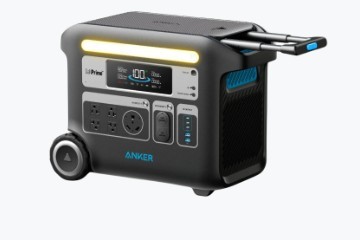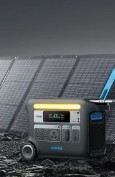Choose the right complete house generator to provide uninterrupted power during unexpected outages. A generator can power your lights, refrigerator, HVAC, and other essentials during a power outage, saving you time and effort. Not all generators are the same, so consider your home’s power needs and the best features before buying one. Whether you need a whole-house generator or a portable backup like the Anker SOLIX F2000 Portable Power Station, making an informed selection can keep your home functional and enjoyable during a power outage.
What Size Generator Do You Need for Your Home?
The amount of electricity your home needs in the event of a power loss will dictate the size of the generator you should purchase. A generator that is not big enough will be unable to power all of your necessary home appliances. In contrast, if the generator is very big, it will waste money on fuel and be expensive to set up. First things first: figure out how much power your most important appliances and systems use in total watts. Think about a versatile alternative like the Anker SOLIX F2000. It is perfect for partial house setups because it can power several devices and supplies up to 2400W.
Calculating Your Home’s Power Requirements
You must know your home’s power needs in detail before buying a generator. The first step in preparing for a power outage is to make a list of all the systems and equipment that are absolutely necessary, such as the HVAC system, the kitchen appliances, and the lights. You may then get the overall power needed by adding up the wattages required to power all of these devices. You can keep vital processes operating smoothly even when the grid goes down with a generator like the Anker SOLIX F2000, which has a capacity of 2048Wh and an output of 2400W.
Whole House vs. Partial Home Generators
You need to choose if you want a generator for the entire house or just a portion of it before you go shopping. If you have a whole-house generator, it can power your entire house, including all of your appliances and lights, even if the electricity goes out. On the other hand, important systems, including medical equipment, sump pumps, and freezers, are the exclusive emphasis of partial house generators. You may get flexible backup power with portable power stations like the Anker SOLIX F2000, which are ideal for partial household use. They provide enough wattage for vital electronics during short-term outages, and they do not cost as much as whole-house units.
Sizing Chart: How to Match Generator Power with Home Needs
Finding the correct power output for your home’s energy demands may be as simple as consulting a generator sizing chart. In order to power necessary appliances in a smaller home, a generator ranging from 5 to 10 kW may be sufficient. However, a bigger home may want 20 kW or even more power. Any household in need of a lightweight but strong power source would do well to consider the Anker SOLIX F2000. Its 2400W output and 4096Wh extendable capacity make it easy to adapt to different energy needs, making it reliable and versatile in times of crisis.
What Key Features Should You Look for in a Whole House Generator?
There is more to choosing a whole-house generator than simply the size; there are important elements that will affect your experience in general. Look for features like automated transfer switches for trouble-free operation, noise-level controls to keep you comfortable, and fuel economy to save money in the long run. Smart smartphone control and solar energy possibilities are two advantages that modern generators like the Anker SOLIX F2000 provide, which enhance both use and sustainability. If you take the time to carefully consider these important aspects, you can be assured that your generator will provide you with the electricity you need without any problem.
Automatic Transfer Switch for Seamless Power Supply
One of the most important features of a whole house generator is an automatic transfer switch (ATS). As soon as it detects a power loss, this gadget will activate your generator and begin supplying electricity to your home. An ATS eliminates the need to manually turn on the generator, which is a huge time saver, particularly while you are not at home or even sleeping. Portable whole-house generators, such as the Anker SOLIX F2000, provide ATS functionality with smart energy management, making it easier to switch between grid and generator power and ensuring that power flows continuously.
Quiet Generator Selection: Noise Level Considerations
Whether you reside in a peaceful area or have limited outside space, the noise level of the generator you choose should be a top priority. Many older models of generators are very noisy, which could be an annoyance to your neighbors and even your own family. Find models with lower decibel levels to avoid this. The Anker SOLIX F2000 is a great example of a silent, powerful generator that would be perfect for usage around the house. With its whisper-quiet operation, you can be certain that your generator will not amplify the noise level during a power outage.
Fuel Efficiency and Tank Size
Because they affect running expenses and the frequency of refilling, fuel efficiency and tank capacity are critical considerations when picking a generator. Conventional generators powered by gasoline, diesel, or propane need sizable fuel tanks to function for long durations, which may be both costly and cumbersome. In contrast, the Anker SOLIX F2000 runs on solar power, so there is no need to worry about expensive fuel refills. It is an effective and sustainable option for homes who want to reduce their costs and environmental impact. Its high solar input of 1000W guarantees rapid recharging and eco-friendly operation.
Conclusion
Knowing your home’s unique power demands and researching characteristics that guarantee efficient and dependable operation is essential when shopping for a whole-house generator. Making the correct decision—whether it is a whole-house generator or a more versatile portable option like the Anker SOLIX F2000—will provide you peace of mind during power outages. If you want your machine to run smoothly, quietly, and economically, you need features like automated transfer switches, minimal noise, and fuel economy. By meticulously evaluating five essential factors when choosing a generator, you can protect your home and guarantee the operation of vital systems during an emergency.






0 Comments